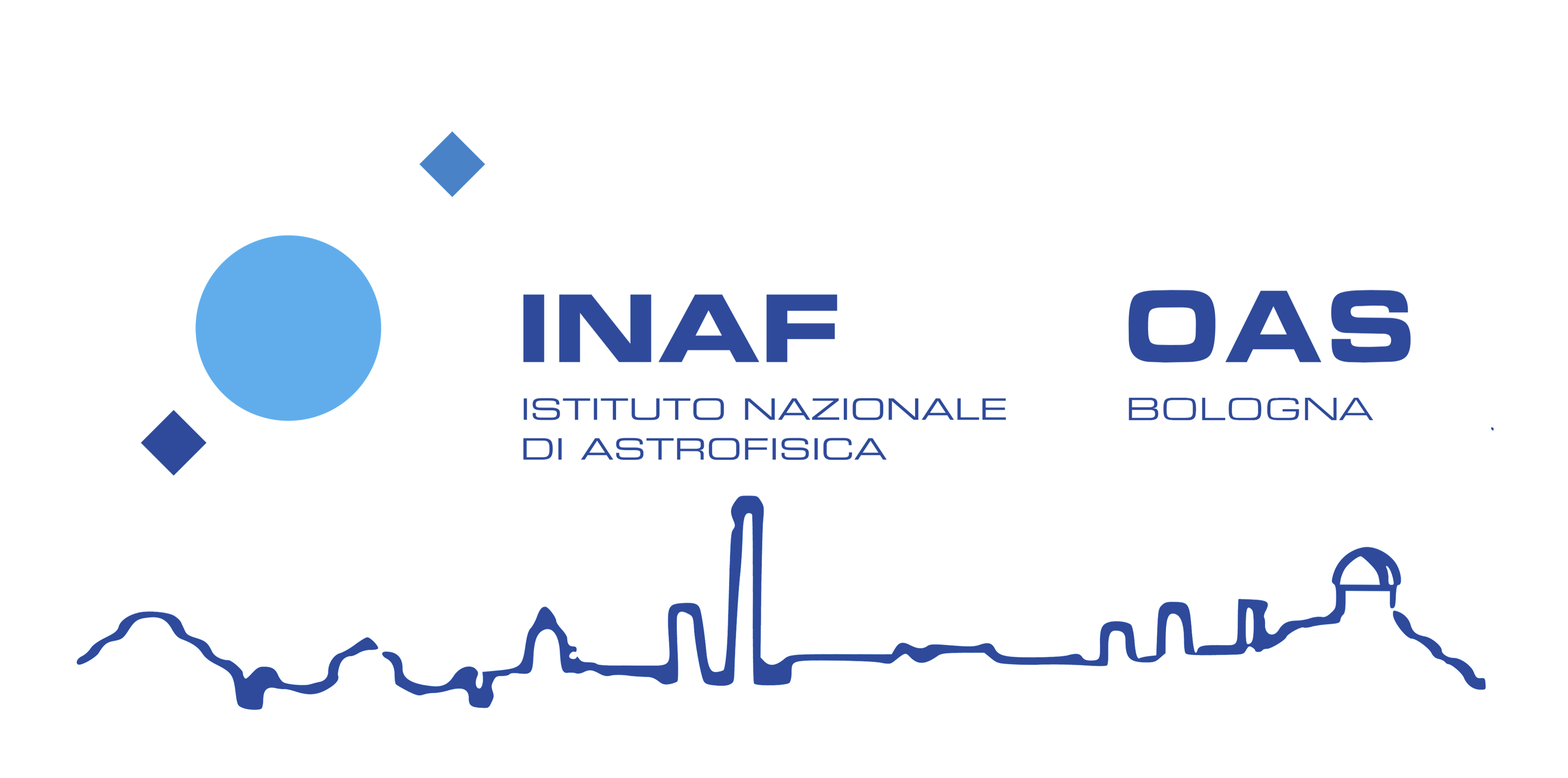
The field around the z=6.31 quasar SDSS J1030+0524
Project Rationale
The existence of supermassive black holes (SMBHs) with MBH = 109 M☉ powering luminous quasars
at z~6 and beyond, represents a persistent challenge for extragalactic astronomy. Theory strongly
argues that these objects must have formed within the most massive dark matter halos (Mhalo ~
1012-13 M☉) situated in the most overdense regions of the early Universe, where large reservoirs of gas
are available for an efficient BH fueling.
Within these environments, high accretion rates can be triggered and sustained by both frequent mergers of proto-galaxies and possibly by the steady
flows of cold gas from which proto-galaxies can form. Such early large scale structures (LSSs), whose cores would eventually evolve into local massive
galaxy clusters, are expected to be traced by significant galaxy overdensities, that may extend up to scales as large as ~10 physical Mpc (pMpc) from the quasar.
The total number and spatial distribution of galaxies in these overdensities, however, depend on the many competing physical processes that promote or prevent
galaxy formation. For instance, both supernovae explosions in some of these galaxies and the release of energy from the QSO itself in the form of radiation and
gas outflows, may heat and expel gas from the dark matter halos in the LSS, hampering further star formation and galaxy assembly.
This "negative feedback" may in fact complicate the detection of these early structures, especially within a few hundreds kpc
from the QSO.
Current observations lag behind theoretical modeling, and there is still no direct measurement of
the environment around early SMBHs. The attempts to directly measure these overdensities have
started since the discovery of high-z QSOs, mainly by selecting Lyman Break Galaxy (LBG) and Lyman
Alpha Emitter (LAE) candidates at the QSO redshift. Yet, all these efforts did not produce
conclusive results.

LBT color image of the field around SDSS J1030+0524. The field is ~25x25 arcmin2, i.e. 8x8 physical Mpc2 at z=6.31. The region covered by deep Chandra data is shown in green. The zoom shows the quasar at the center of the field.
LBT program
In 2012 we started an optical imaging campaign to search for galaxy overdensities
around four luminous QSOs at z~6 with the Large Binocular Camera at the Large Binocular Telecope. The large field of view of the LBC
(~25x25 arcmin2) allowed us to search for z~6 LBG candidates on scales as large as 4 projected Mpc from the QSOs.
When combining the four fields, we found significant evidence for large-scale overdensities of LBG
candidates around early quasars (Morselli et al. 2014).
The field around SDSS J1030+0524, a z=6.31 QSO powered by a billion solar mass black hole, was found to be the most overdense, reinforcing the results of previous small-scale studies with ACS/HST. In 2016 we obtained deep-and-wide near-IR imaging of the J1030 field with WIRCAM at the CFHT. Using these new observations plus archival Spitzer/IRAC data, we pushed the selection of z~6 galaxy candidates to fainter fluxes, measured photometric redshifts, and improved the rejection of contaminants, reinforcing the large scale overdensity estimate (Balmaverde et al. 2017).
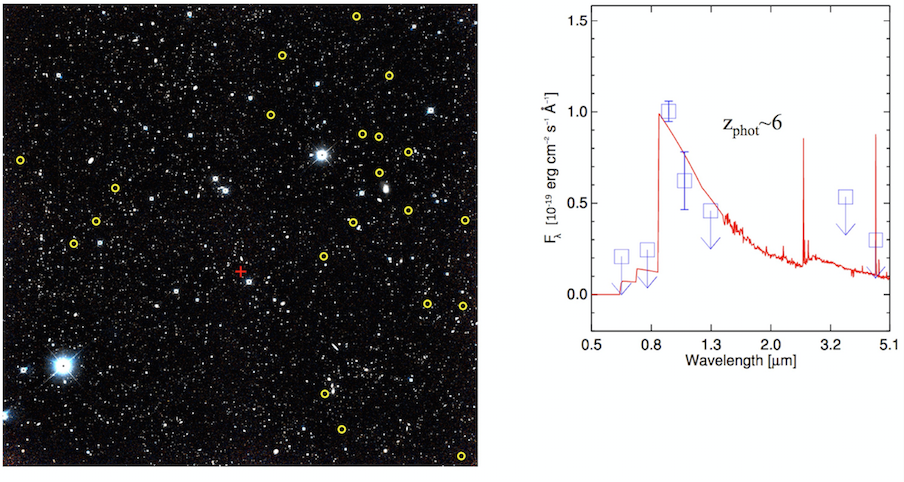
Distribution on the sky and stacked SED of the z~6 LBG candidates around SDSS J1030+0524 (Balmaverde et al. 2017).
LSS at z≃6.3 around the central luminous QSO: "the Web of the Giant"
Using three of the largest telescopes around the world - namely, the Large
Binocular Telescope (LBT), the ESO Very Large Telescope (VLT), and the
W.M. Keck Observatory Telescope - we were able to confirm the presence of a Large Scale Structure (LSS)
around SDSS J1030+0524.
The structure is populated by at least six galaxies, whose redshifts were
determined through multi-object spectroscopic observations lasting up to eight hours.
The redshifts of the six galaxies cover the range between 6.219–6.355 and,
assuming that the peculiar velocities are negligible, this range corresponds to
radial separations of ±5 physical Mpc from the QSO.
(Mignoli et al. 2020)
The result is significant at more than 3.5σ and the level of the
galaxy overdensity is at least 1.5–2 within the large volume sampled
(∼780 physical Mpc3). This is the first spectroscopic
identification of a galaxy overdensity around a supermassive black hole in the
first billion years of the Universe. This finding helps us better understand
how supermassive black holes formed and grew to their enormous sizes.
It supports the theory that the most distant and massive black holes form and
quickly grow within massive (>1012M
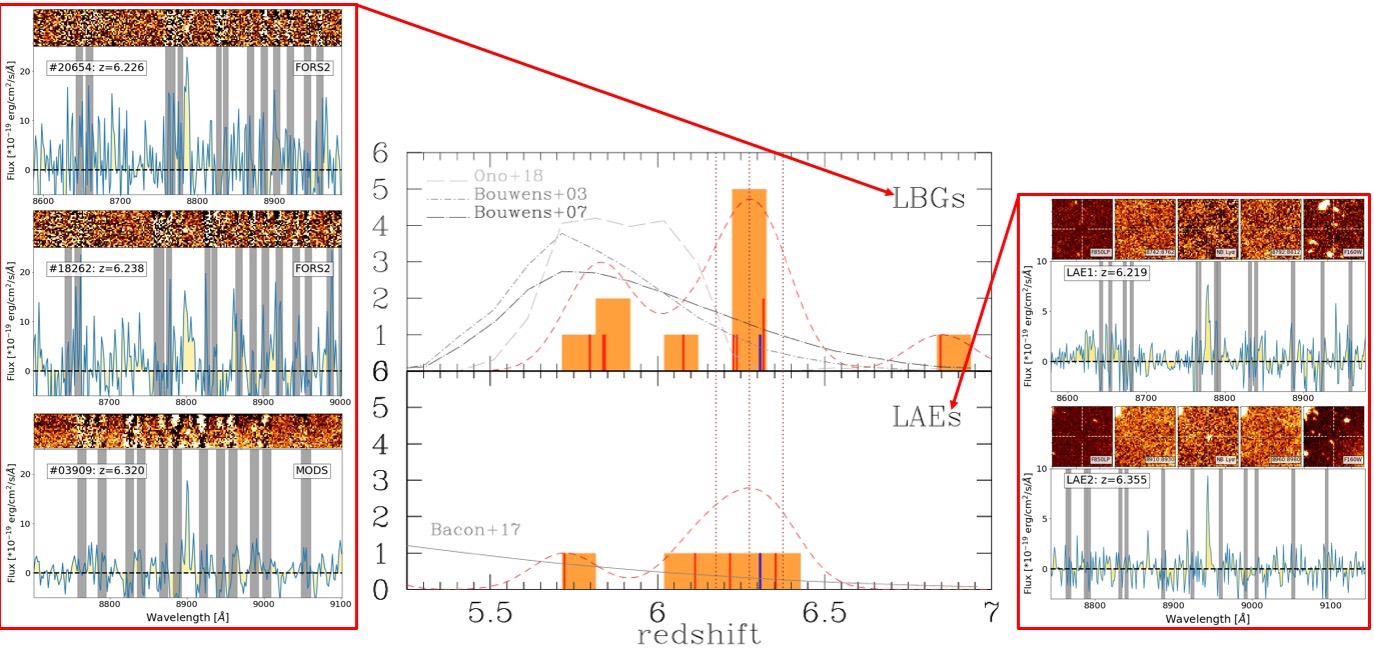
Spectra of five of the six galaxy members of the z~6.3 LSS around SDSSJ1030+0524 and redshift distribution of spectroscopically confirmed high-z galaxies in the field (Mignoli et al. 2020).
Chandra Large Program
The field around SDSS J1030+0524 features the best multi-band coverage among all known z~6 quasars. Besides the data already mentioned above, the quasar is covered by HST/WFC3 data. The field has been also observed by Spitzer IRAC (30x30 arcmin2) and MIPS (~12x12 arcmin2), and by the VLA at 1.4GHz (~ 30 arcmin diameter). Furthermore, it is part of the Multiwavelength Chile-Yale survey (MUSYC), that provides additional imaging in UBVRIzJHK.In 2015, a 500ks Chandra Large Program was granted to our group with the aim of obtaining the best X-ray spectrum of a z>6 quasar to date and investigate the presence of moderate-luminosity AGN within the candidate large scale structure around the quasar. The observations, performed in 2017 with the ACIS-I array, revealed an unexpectedly high variability level for such a luminous quasar: its X-ray spectrum was significantly harder and fainter than what was observed in the past, suggesting large changes in the quasar accretion rate or obscuration level, or both. The results on the quasar properties have been published in Nanni et al. 2018.
The Chandra survey in the J1030 field is currently the deepest X-ray look at at z=6 quasar and the 5th deepest X-ray survey in general after the 7Ms CDFS, the 2Ms CDFN, the 800ks AEGIS survey and the 400ks survey in the SSA22 field. It reaches a 0.5-2 keV flux limit of 6x10-17 erg cm2 s-1 in the central sq. arcmin. Its excellent multi-band coverage guarantees prompt identification of X-ray sources. The catalog of 256 X-ray sources detected in the field has been published in Nanni et al. 2020. For a subsample of candidate obscured AGN, we derived a redshift estimate based on X-ray spectral analysis. The results are published in Peca et al. 2021.
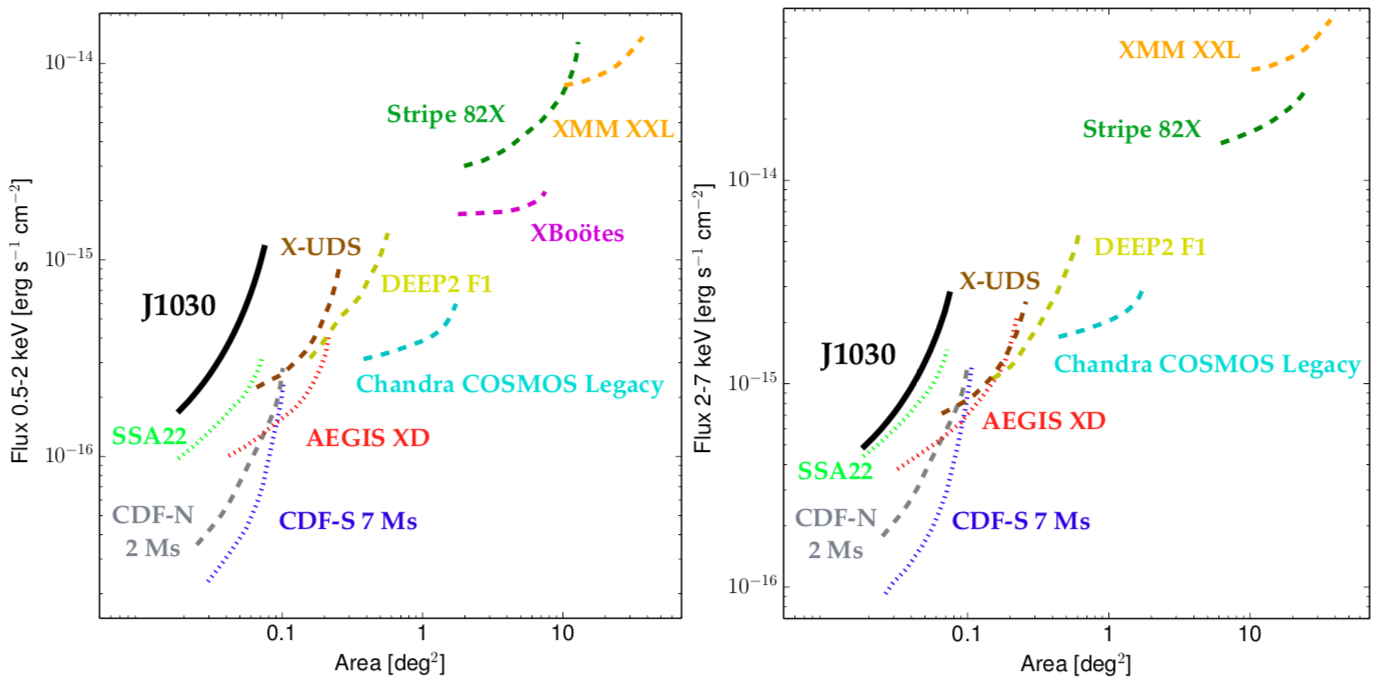
Sensitivity in the 0.5-2 keV band (left) and 2-7 keV band (right) vs area covered for the major X-ray surveys including J1030. From Nanni et al. 2020.
Because of its equatorial location, SDSS J1030 is in fact an ideal field to exploit current and future ground based instrumentation on both hemispheres, and an extended spectroscopic campaign with LBT was performed to compute a redshift for a large fraction of the Chandra J1030 population. Overall, we measured a spectroscopic redshift for 123 sources (51% of the sample); we then took advantage of the excellent multiwavelength coverage of the J1030 field to compute a photometric redshift through fitting of the spectral energy distribution (SED) for the remaining sources. The results of the spectro-photometric campaign are reported in Marchesi et al. 2021.
More details, as well as the high-level scientific data products derived from the Chandra observations, can be found at the dedicated page.
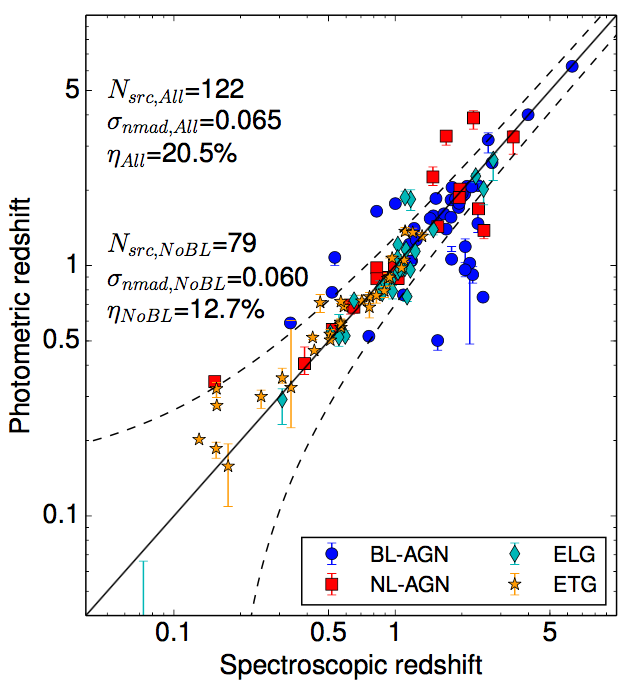
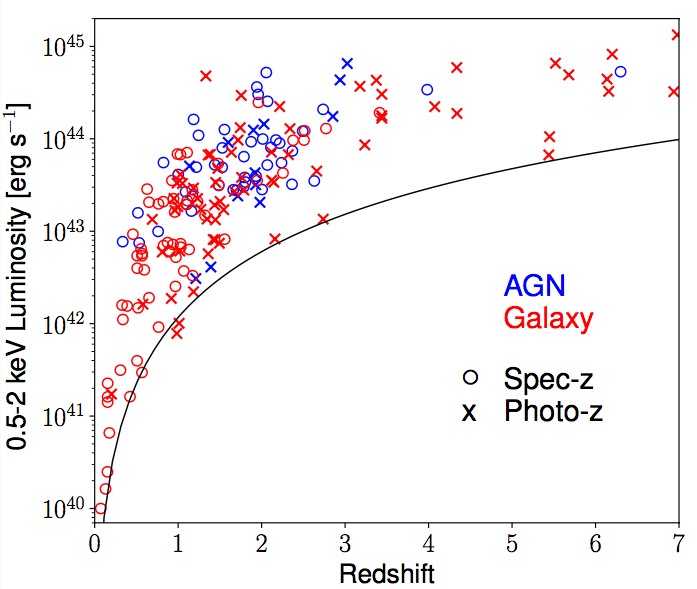
Left: photometric sources as a function of the spectroscopic one for 122 Chandra J1030 sources having both spectroscopic and photometric redshift. Different colors highlight different spectroscopic classes: the majority of outliers are broad-line AGN, whose SEDs are more difficult to fit to obtain a reliable redshift measurement. Right: 0.5-2 keV luminosity as a function of redshift for the Chandra J1030 sources. Marchesi et al. 2021.
JVLA deep observation
VLA 1.4 GHz observations of the central part of the field have been published by Petric et al. 2003 and re-analysed by us. The QSO itself was not detected down to a sensitivity of
~20 μJy rms (constraining the 1.4 GHz rest-frame luminosity to < 5x1025 W Hz−1 at 3σ). Such observations revealed an FR II radio galaxy at the center of the field, that we later discovered to be associated with a proto-cluster at z=1.69.
New radio continuum JVLA imaging was obtained at L-band (1-2 GHz) in 2018. The L-band primary beam response (FWHM∼ 30 arcmin) nicely matches the entire region of interest, and in particular entirely encompasses the Chandra field of view. These observations reach a 1σ sensitivity of ∼2.5 μJy at the center of the field, making it of the deepest radio-survey to date. We extracted a catalogue of 1489 radio-sources down to a flux density of ∼12.5 μJy (5σ), for which we presented source counts, finding good agreement with recent measurements and models. We detected for the first time the QSO in the radio band, and derived an optical radio-loudness R = 0.62 ± 0.12, that makes it the most radio-quiet AGN at z ≳ 6 discovered so far.
Thanks to the sinergy between the deep JVLA and Chandra observations, we investigated the relation between radio and X-ray luminosity of 243 X-ray selected sources in a wide redshift range (0 ≲ z ≲ 3), for which Marchesi et al. 2021 provided spectrocopic and/or photometric redshifts and classification. We found significant correlations between the radio and X-ray luminosities of different source populations and interpreted them as signatures of different accretion processes. These results are presented D'Amato et al. 2022.
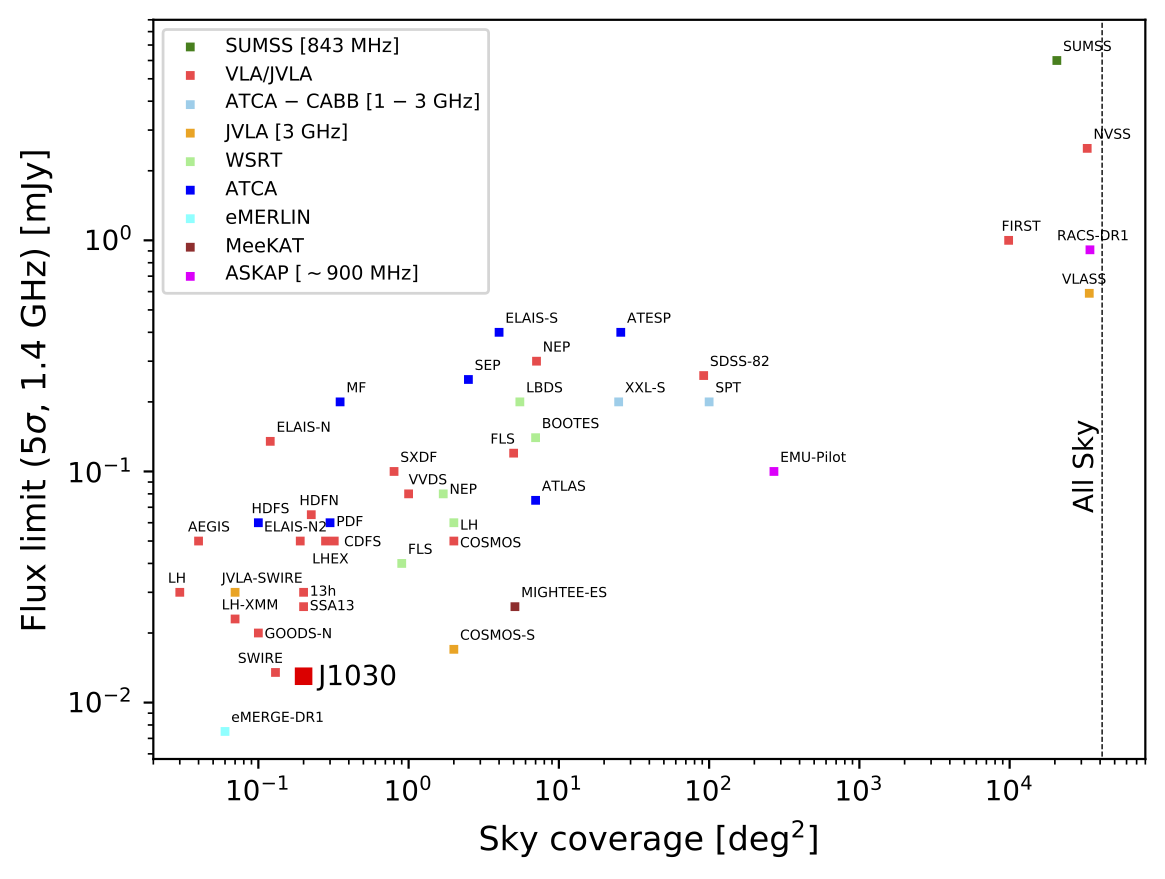
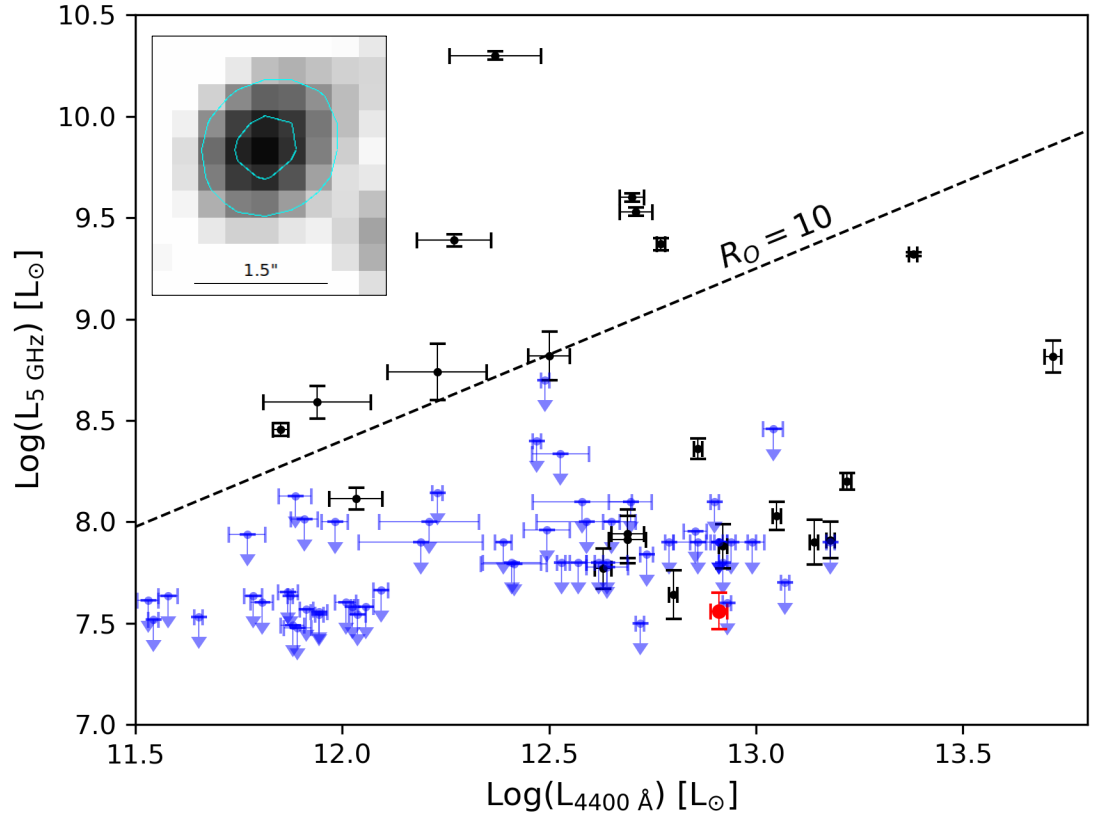
Left: Sky coverage vs. (5σ) sensitivityατ 1.4 GHz for a collection of available radio surveys to date including J1030. Right: Rest-frame optical luminosity at 4400 Å vs. rest-frame radio luminosity at 5 GHz for known quasars at z≳6 including J1030 (red point). Both figures are from D'Amato et al. 2022.
Proto-cluster at z=1.7
The combination of deep X-ray, radio and optical data allowed the discovery of another remarkable system at the center of the J1030 field, that is a galaxy overdensity at z=1.69 surrounding a powerful FRII radio galaxy.
The structure is mostly populated by blue, star forming galaxies, and likely constitutes the progenitor of a local cluster caught in its main assembly phase. The Chandra 0.5Ms observation - the deepest so far for a distant FRII - revealed that its nucleus hosts a luminous, Compton-thick QSO, and that four spots of diffuse X-ray emission are present around it, the most significant around the Eastern lobe of the radio galaxy. The origin of the whole X-ray emission is not entirely clear, as the four spots have apparently different spectral shapes. Most likely, the main spot is produced by an expanding bubble of hot gas (T > 5 keV) shock-heated and inflated by the FRII jet. Significant contribution from Inverse Compton scattering of CMB photons by the relativistic electrons in the lobe (IC-CMB) cannot be ruled out though. Four proto-cluster members lie at the sharp boundary of the main spot of diffuse X-rays and their transverse and radial separations are consistent with the bubble size (∼250 kpc diameter). The star formation rates per unit stellar mass of these four galaxies are the highest of all proto-cluster members and 2-5 times higher than the average of field galaxies with equal stellar mass and redshift. This argues for remarkable positive AGN feedback on large scales, in which the expanding hot gas bubble compresses the galaxies’ inter-stellar medium promoting star formation.
This is the first time that an accreting supermassive black hole is seen to exert positive feedback on multiple galaxies at hundreds of kpc distance. If confirmed, this mechanism will represent a new and important process of large scale structure formation.
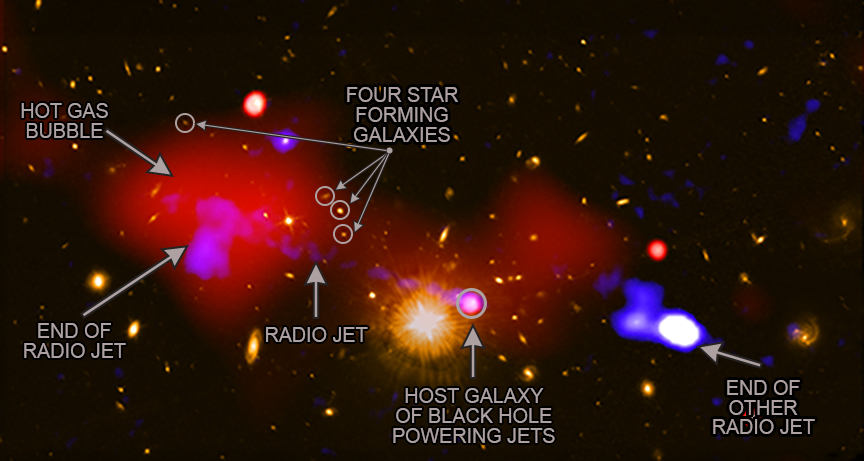
Composite Chandra/HST/VLA image of the z=1.69 FRII radio galaxy and associated protocluster region. The main components are as labeled (credit NASA/CXC)
The above results have been published in Gilli et al. 2019, and have been the subject of a NASA/CXC press release.
We observed the system at 3mm with ALMA and at 150MHz with LOFAR. ALMA observations probe the molecular gas content of the structure, including its galaxy members, whereas LOFAR observations probe populations of old electrons that are invisible at GHz frequencies and may fill the observed X-ray bubble. Three new, gas-rich (MH2 = 1.5-4.8 x 1010 M☉) protocluster members were discovered by ALMA through their CO(2-1) emission. A large, ~ 2 x 1011 M☉ reservoir of molecular gas, again traced by CO(2-1), was also revealed around the FRII host galaxy. By combining ALMA with previous results, we found that the overall structure will likely evolve into a >1014 M☉ galaxy cluster by z=0, and that the FRII host is the likely progenitor of the Brightest Cluster Galaxy (D'Amato et al. 2020). We performed a spectral energy distribution (SED) analysis in the optical/infrared bands of the FRII host galaxy (D'Amato et al. 2021), finding that it features a vigorous star formation rate (SFR) of ∼570 M☉/yr and a stellar mass of M* ∼ 3.7 × 1011 M☉. The corresponding specific SFR = 1.5 ± 0.5 Gyr-1 is high, and classifies this object as a starburst galaxy that will deplete its molecular gas reservoir in ∼ 3.5 × 108 yr. The reduction and analysis of LOFAR data are ongoing.
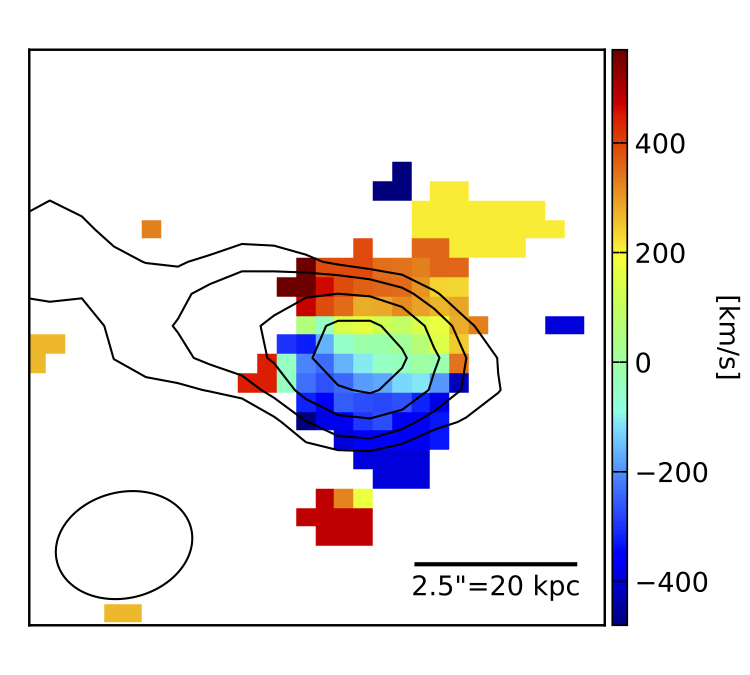
CO(2-1) velocity map around the z=1.69 FRII radio galaxy. Black contours show the VLA radio emission. The black ellipse is the ALMA beam. From D'Amato et al. 2020.
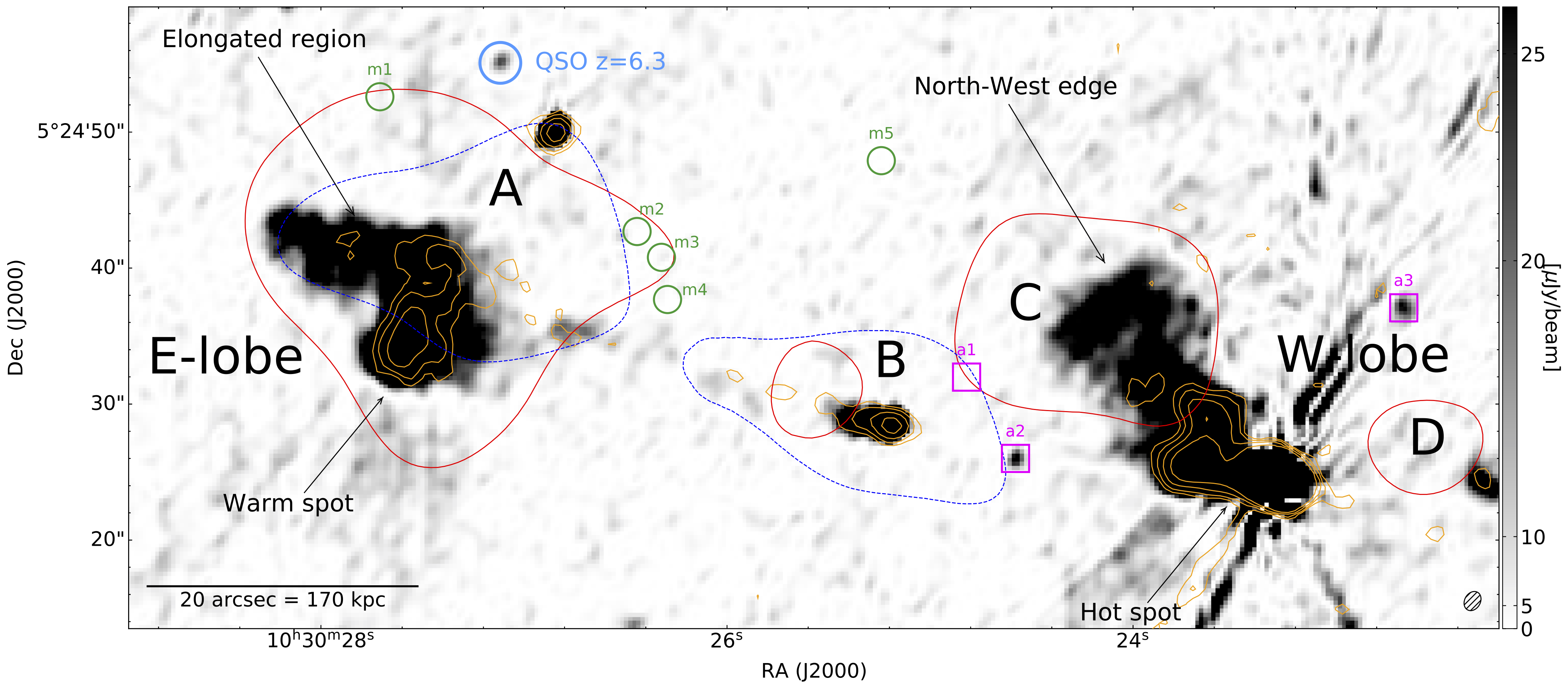
JVLA image of the z=1.69 FRII and associated protocluster region. Orange contours refer to the past VLA observations at 1.4 GHz. Blue and red contours show hard and soft X-ray diffuse emission, respectively: the main spots are as labeled (A, B C and D). The positions of protocluster members discovered by MUSE and ALMA are indicated as green circles and magenta boxes, respectively (D'Amato et al. 2022).
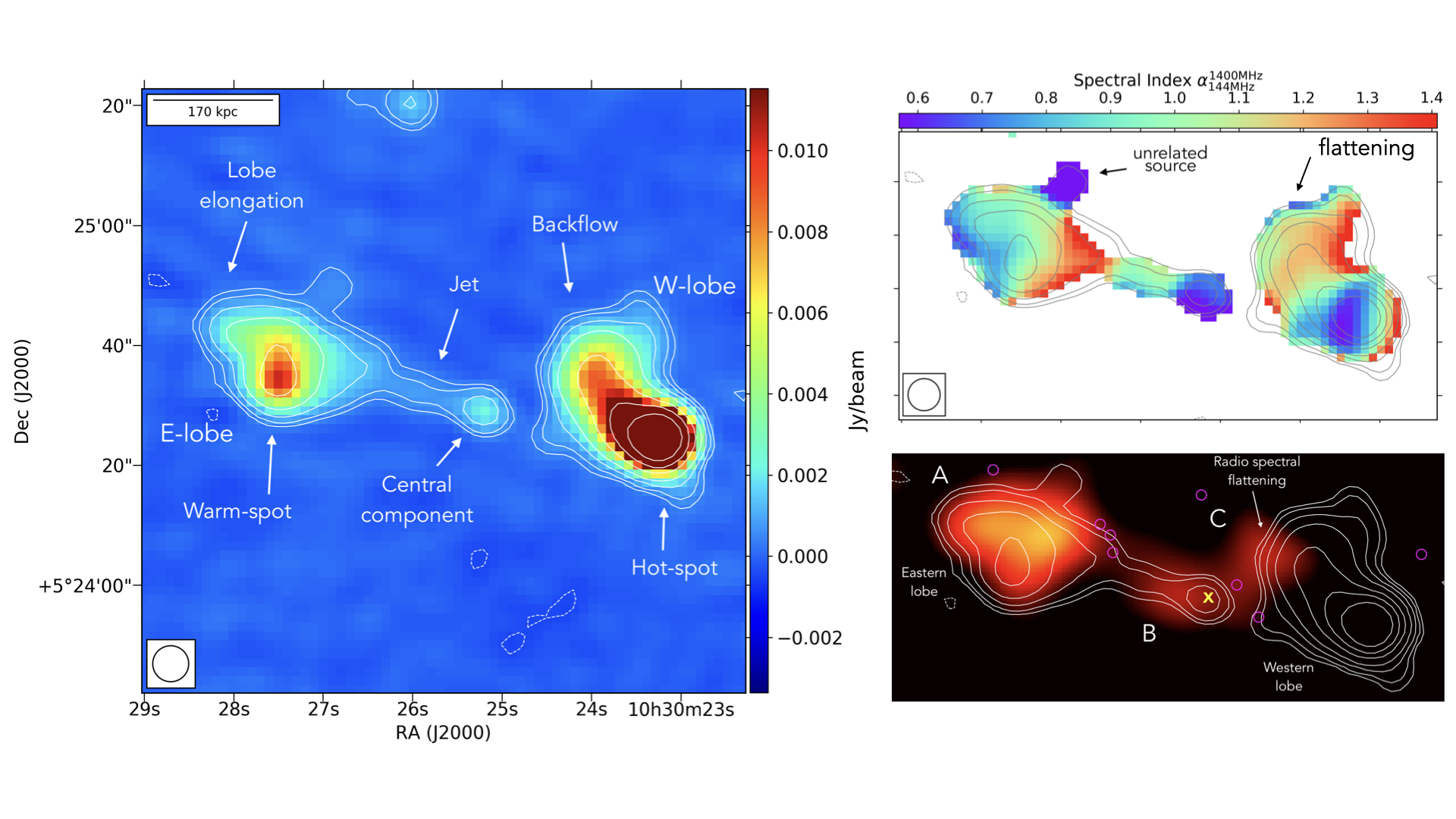
Left panel: LOFAR image of the z=1.69 FRII radio galaxy at 144 MHz. Top right panel: Radio spectral index map in the frequency range 144-1400 MHz. Bottom right panel: X-ray diffuse emission as seen by Chandra at 0.5-7 keV with LOFAR contours overlaid (Brienza+2023).